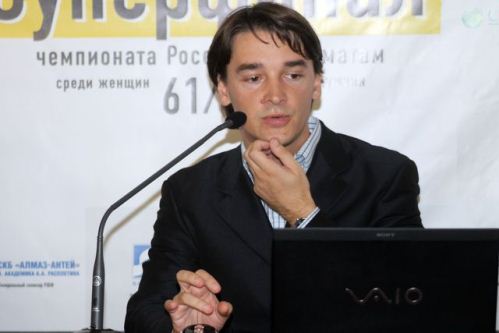Chess blog for latest chess news and chess trivia (c) Alexandra Kosteniuk, 2011
Hi everyone,
For a chess-lazy-fun Sunday here is a real cool translation in English of the Russian article of Alexander Morozevich explaining his win over Peter Svidler from the ChessInTranslation.
We have also added the super Chess Blog gameplayer here so you can run the full game before you check out the analysis.
A little of the shine was taken off Peter Svidler’s victory at the Russian Championship Superfinal when he lost in the final round. The mercurial Alexander Morozevich later showed an audience how he used a rare opening line to beat Svidler and snatch clear second place in the tournament.
Morozevich’s demonstration was transcribed by Vladimir Barsky in his Round 7 photo report for the Russian Chess Federation website.
Alexander Morozevich – Peter Svidler
Notes by Alexander Morozevich
1.d4 Nf6 2.c4 g6 3.Nc3 d5 4.Nf3 Bg7 5.Qb3 dxc4 6.Qxc4 0-0 7.e4 a6 8.e5 b5 9.Qb3 Nfd7 10.Be2 A rare move, to which I think Peter reacted correctly.
10…c5 11.e6 fxe6 12.Qxe6+ Kh8 13.dxc5 Ne5 Also possible was 13…Nxc5 14.Qe3 with a sufficiently playable position.
14.Qd5 Qxd5 15.Nxd5 Bb7 It seems Peter mixed something up. I thought Black had to start with 15…Nxf3+, and here you get an approximately equal ending: 16.Bxf3 (there’s nothing after 16.gxf3 Nc6) 16…Bb7 17.Nc7 Bxf3 18.gxf3 Ra7 19.Ne6 Rxf3. White can try to make use of the c5-passed pawn, but overall I think the position’s about equal.
16.Nc7 Nxf3+ 17.gxf3 White wouldn’t have had this option if Black had started with 15…Nxf3+, although probably nothing terrible has yet happened.
17…Bxf3 An amazing move which is hard to comment on. It seemed to me that the exchange sacrifice with 17…Nc6 was going too far: 18.Nxa8 Bxa8 19.0-0 Nd4 20.Bd1, and it’s not clear Black has enough compensation. Normally here you’d have to play 17…Ra7 18.Ne6 Bxf3 19.Nxf8 Bxh1 20.Ne6. Here Peter hadn’t noticed in advance that if the dark-squared bishop retreats there’s the move f2-f3, and he wasn’t too thrilled about that prospect. While after 20…Bd5 21.Nxg7 Kxg7 White can still torture his opponent. Svidler tried to avoid that unappealing defence, but the move he made works out badly.
18.Bxf3 Ra7 19.Nxb5 axb5 20.Ke2 White’s got an extra pawn and, in my view, a won position.
20…Ra6 A tricky move.
21.Bb7 The only trap, which it’s a miracle I didn’t fall into, was 21.Rd1 Raf6 22.Rd3 Na6, and somehow the knight starts to jump around.
21…Re6+ 22.Be3 Bxb2 23.Rab1 Bd4 24.Rxb5 Here Black already has great difficulty making moves.
24…Na6 25.c6 Nc7 26.Rb3 Rf4 27.Rd1 Kg7 28.a4
28…Bc5 After 28…Bxe3 29.Rxe3 Rxa4 30.Rd7 I couldn’t see how Black could save himself.
29.Rd7 Bd6 30.Rd3 Ne8 31.a5 Black resigned. After, for example, 31…Ra4 32.a6 Bxh2 33.Kf1 there’s no salvation.

Unfortunately the video of Morozevich’s demonstration no longer seems to be available at the Russian Chess Federation website.
Hi everyone,
For a chess-lazy-fun Sunday here is a real cool translation in English of the Russian article of Alexander Morozevich explaining his win over Peter Svidler from the ChessInTranslation.
We have also added the super Chess Blog gameplayer here so you can run the full game before you check out the analysis.
A little of the shine was taken off Peter Svidler’s victory at the Russian Championship Superfinal when he lost in the final round. The mercurial Alexander Morozevich later showed an audience how he used a rare opening line to beat Svidler and snatch clear second place in the tournament.
Morozevich’s demonstration was transcribed by Vladimir Barsky in his Round 7 photo report for the Russian Chess Federation website.
Alexander Morozevich – Peter Svidler
Notes by Alexander Morozevich
1.d4 Nf6 2.c4 g6 3.Nc3 d5 4.Nf3 Bg7 5.Qb3 dxc4 6.Qxc4 0-0 7.e4 a6 8.e5 b5 9.Qb3 Nfd7 10.Be2 A rare move, to which I think Peter reacted correctly.
10…c5 11.e6 fxe6 12.Qxe6+ Kh8 13.dxc5 Ne5 Also possible was 13…Nxc5 14.Qe3 with a sufficiently playable position.
14.Qd5 Qxd5 15.Nxd5 Bb7 It seems Peter mixed something up. I thought Black had to start with 15…Nxf3+, and here you get an approximately equal ending: 16.Bxf3 (there’s nothing after 16.gxf3 Nc6) 16…Bb7 17.Nc7 Bxf3 18.gxf3 Ra7 19.Ne6 Rxf3. White can try to make use of the c5-passed pawn, but overall I think the position’s about equal.
16.Nc7 Nxf3+ 17.gxf3 White wouldn’t have had this option if Black had started with 15…Nxf3+, although probably nothing terrible has yet happened.
17…Bxf3 An amazing move which is hard to comment on. It seemed to me that the exchange sacrifice with 17…Nc6 was going too far: 18.Nxa8 Bxa8 19.0-0 Nd4 20.Bd1, and it’s not clear Black has enough compensation. Normally here you’d have to play 17…Ra7 18.Ne6 Bxf3 19.Nxf8 Bxh1 20.Ne6. Here Peter hadn’t noticed in advance that if the dark-squared bishop retreats there’s the move f2-f3, and he wasn’t too thrilled about that prospect. While after 20…Bd5 21.Nxg7 Kxg7 White can still torture his opponent. Svidler tried to avoid that unappealing defence, but the move he made works out badly.
18.Bxf3 Ra7 19.Nxb5 axb5 20.Ke2 White’s got an extra pawn and, in my view, a won position.
20…Ra6 A tricky move.
21.Bb7 The only trap, which it’s a miracle I didn’t fall into, was 21.Rd1 Raf6 22.Rd3 Na6, and somehow the knight starts to jump around.
21…Re6+ 22.Be3 Bxb2 23.Rab1 Bd4 24.Rxb5 Here Black already has great difficulty making moves.
24…Na6 25.c6 Nc7 26.Rb3 Rf4 27.Rd1 Kg7 28.a4
28…Bc5 After 28…Bxe3 29.Rxe3 Rxa4 30.Rd7 I couldn’t see how Black could save himself.
29.Rd7 Bd6 30.Rd3 Ne8 31.a5 Black resigned. After, for example, 31…Ra4 32.a6 Bxh2 33.Kf1 there’s no salvation.

Unfortunately the video of Morozevich’s demonstration no longer seems to be available at the Russian Chess Federation website.
From Alexandra Kosteniuk's
Also see her personal blog at





No comments:
Post a Comment
Note: Only a member of this blog may post a comment.